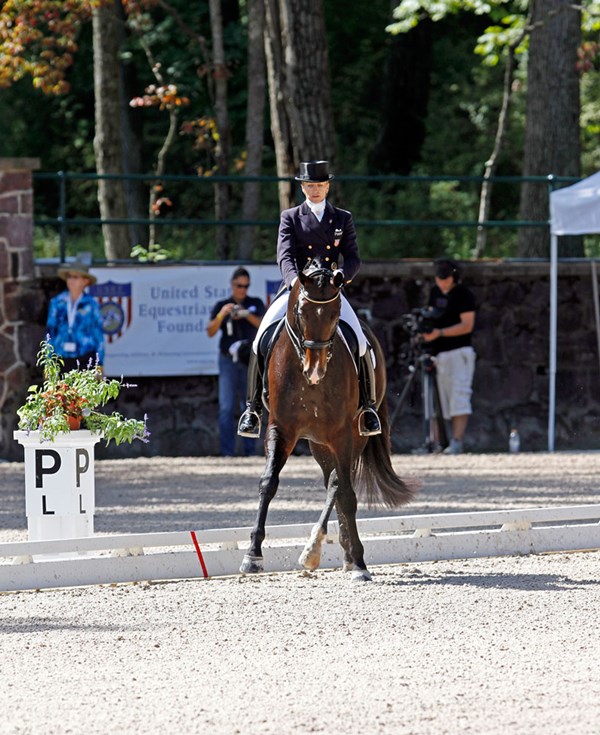
From his birth in New Mexico to his arrival at the national championship for young horses, Pikko del Cerro HU (aka Cerro) has journeyed far in his life. Foaled in 2003 at Horses Unlimited (HU), in Albuquerque, New Mexico, he was named the 2012 U.S. Equestrian Federation (USEF) Developing Horse Grand Prix Champion with his trainer and rider, U.S. Olympian Lisa Wilcox. His name means “top of the hill,” and he is, indeed, reaching the summit of dressage as he is now scoring in the 70th percentile and has won the World Dressage Master’s CDI3* Qualifier. Former U.S. Technical Advisor and Coach Anne Gribbons named Cerro one of three young superstars in U.S. dressage.
I have always trained Pikko del Cerro HU and every other horse that comes into my barn with a particular focus on straightness. When we talk about the Training Scale and straightness in terms of developing dressage horses, it is important to remember that they would prefer to travel crooked with their shoulder falling in either direction. That is why one of the most important things I do in my training is ride a lot of shoulder-in. My horses practically live in it and it is my preferred positioning. Commonly, you hear people talking about riding a slight shoulder-fore to confirm straightness so that the horse’s outside front foot is in line with the outside hind foot and the two are traveling on the same track. However, I like to take it a step further and add the option of the shoulder-in since it allows me to add more bend. For example, I might warm up in shoulder-fore and then add shoulder-in to prepare for movements like the half pass, volte or pirouette—some of the movements that benefit from this work.
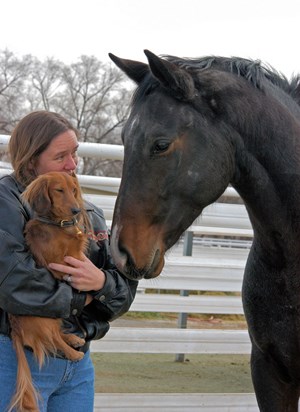
One important aspect of how I ride the shoulder-fore and shoulder-in is that I guide the forehand around the horse’s hind end. When I have correct control of the shoulder through the outside rein, the horse becomes genuinely straight. Without riding with control of the outside shoulder, the horse can easily disconnect from your outside aids and start to lean on the wall.
With this idea of shoulder control in mind, let us think about trying to turn that same horse onto a circle. A horse that is turned with the support of the outside rein and a fully weighted inside stirrup iron positioned at the girth as well as the outside leg placed behind the girth (guarding that the haunches don’t swing off the circle) will stay “straight” on the circle. His whole body will stay on the same track as he follows the line of travel. If that same horse is not straight on the track and is leaning on the wall for support, we will find it a little difficult to turn because his shoulder has fallen out and, therefore, he will fall on his forehand.
Now the majority of weight is balanced on the inside rein, blocking the horse from correctly stepping through with his inside hind leg. The torque necessary on the outside rein to bring the now heavily weighted forehand/outside shoulder back to its correct shoulder-fore position is immense, creating rhythm and balance issues throughout the circle. These will obviously lead to incorrect shapes and sizes of circles. To avoid this issue, it is important to maintain the proper shoulder-fore position prior to beginning the circle.
The hardest part of the circle can be keeping the outside limbs in line, especially when you shrink down to the smaller voltes.
For balance, riders tend to hold on to the rein on the side they are the weakest. In most cases, this is the left rein. This will create a hard, bracing connection because it never gives. Riders must work at becoming bilateral themselves first before they can truly make their horses bilateral. This takes a lot of training, but the better balance you have, the more coordinated and effective you can be on both sides.
As you and your horse develop straightness, you should easily be able to ride movements like the change of direction from B to E. At B, ride a shoulder-fore to get onto the line between B and E, then change to shoulder-fore on the opposite rein as you cross X and turn onto the new direction at E. You know you are straight because you have been in control every step.
Similarly, riding shoulder-fore or shoulder-in a few strides before the advanced movements will prepare you for success. For example, in half pass you often see the haunches leading or the shoulder falling out. To prevent this crookedness, I like to think of the half pass as a shoulder-in on the diagonal.
These problems can also come up in the flying changes, and it is not uncommon to see a horse’s shoulder fall out in the single or tempi changes. Riding a simple shoulder-fore feeling from change to change will correct that.
We can take the concept of outside control a step further with the canter pirouettes. The key to the pirouette is to come into it in a slight shoulder-fore as we did with the previous movements. This will set you up for success when you need to move the shoulders around to execute the movement. It’s the feeling of your outside leg making the horse’s outside hind twice as active. Imagine you are getting impulsion
from your horse’s outside hind leg in the same way a person pushes through a turn on a skateboard. If you do not have that outside control and outside power, you are not set up for the inside hind leg to take the weight it needs for a proper pirouette. Instead, you will get incorrect rotation with your horse throwing himself through the turn.
As you can see, whether you are trotting or cantering on the track or riding piaffe or flying changes off the rail, controlling the shoulder allows your horse to travel in a way that is straight and, therefore, correct.
Lisa Wilcox won a team bronze medal for the United States at the 2004 Olympic Games in Athens, Greece, and a team silver medal at the 2002 World Equestrian Games in Jerez, Spain. She earned individual silver at the 2000 Open European Championships. After 12 years in Europe, she is now based in Wellington, Florida (lisa-wilcox.com).
Shoulder Control on Bending Lines

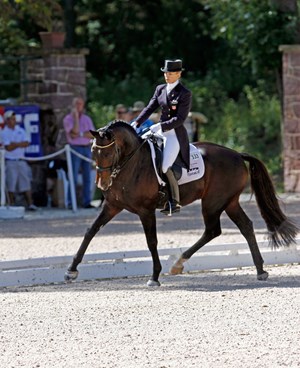
Shoulder Control in the Pirouette
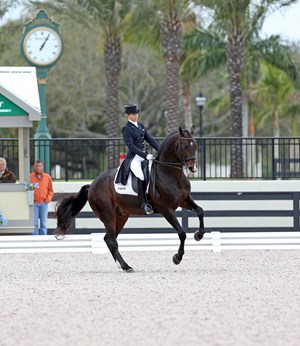
Shoulder Control Through the Highest Levels
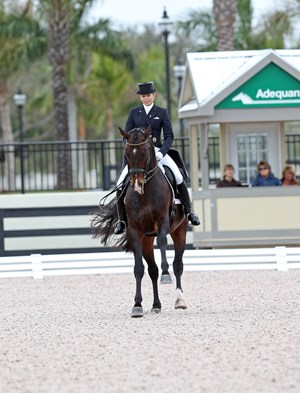
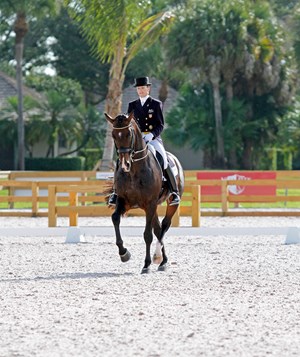
A U.S.-Bred Grand Prix Horse’s Story
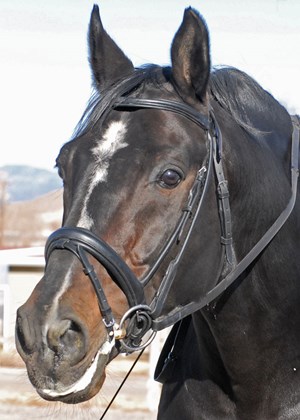
By Charlene Strickland
Pikko del Cerro (aka Cerro) is by Pik L and out of Rohweena, both Hanoverians imported to the United States from Germany. Pik L (Pik Bube II/Abajo xx) is a 16.2-hand stallion foaled in 1993. Pik L stood at stud at Löhden Sportpferde in Heeslingen, Germany, where owner Anne Sparks and trainer Mary Howard found him in 1999. He had competed at Germany’s prestigious Bundeschampionat as a 4-, 5- and 6-year-old before going on to place fourth at the 2003 Pan American Games with Cesar Parra riding. He was later shown at Grand Prix by Danish trainer Mikala Gundersen. Today he’s back at Sparks’ Horses Unlimited (HU) and ridden by his owner.
Cerro’s dam, Rohweena (Rohdiamant/Grundstein II), is a 16.2-hand mare foaled in 1998. In 2000, Sparks saw her on a video. “I had a VHS tape from Lora Schorlemer, who was my mentor,” she says. “I showed that tape to everyone, saying, ‘Look what a great walk this mare has.’” Sparks chose Rohweena to breed to her new stallion, and Cerro was her first foal.
Cerro lived outside that spring and summer in a pasture with other mares and foals, and he was halter-broke before he was inspected and branded by the American Hanoverian Society (AHS) as a 7-month-old. Rohweena was also presented at the 2003 AHS inspection. In the Mare Performance Test, the inspectors, Gerd Zuther and George Walker, gave her good scores in free jumping, 8 on both style and ability. Since then, she has produced foals also of excellent quality—a full brother and two sisters to Cerro.
Soon Cerro was weaned and moved to a pasture with six colts. “We weaned them in October,” says farm manager Mario Sandoval. For the next two years, Cerro lived outside and earned the nickname “Burro” or “Donkey” because he liked to hang back on the lead rope, like a donkey. Robert Meseroll, a friend of Sparks, visited the farm in summer 2005. Seeing the quality of the HU horses, he suggested that the farm haul some of its best to show at Dressage at Devon in Pennsylvania. He helped Sparks choose the horses, which included Cerro.
That September, Cerro was hauled the 1,900 miles to Devon, where he scored 90 in his first class. “I was in the warm-up ring and saw the scoreboard,” remembers Sparks. “Cerro was my first horse ever shown in-hand. At that Devon show, he went in the ring first out of all my horses. To get a 90—it was lovely.” He went on to earn the Born in the USA award and was Reserve Champion Colt/Gelding.
Cerro had another year of growing in the farm’s pastures. In 2006, he was one of the youngsters that assistant farm manager Alfonso Estrada broke to saddle during the summer. “Cerro was not started like a dressage horse. He was started like a Western horse,” says Sparks.
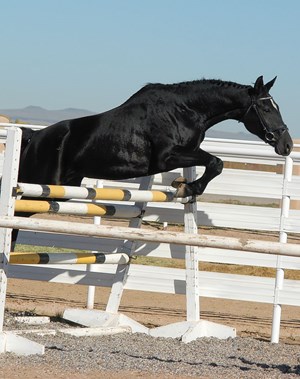
After a second show at Devon, Cerro stayed in the East, moving to Wellington, Florida, in January 2007 with trainers Mikala and Henrik Gundersen. “Mikala recognized his talent as a 4-year-old,” says Sparks.
“When I got him, he was barely broken,” says Mikala. “I could just steer him around the arena. [In his training] he was very straightforward with everything. I rode him in normal soft bits—the Sprenger double-jointed snaffles.”
Cerro’s first U.S. Equestrian Federation (USEF) show under saddle was that year, and he won the Materiale 4- and 5-year-old stallion or gelding class at Raleigh, North Carolina, with 81.3 percent. He qualified and won the 4-year-old championship at the USEF/Markel National Young Horse Dressage Championships and at Dressage at Devon. “It’s fun to have a horse that you know can get a 9 for the walk,” says Gundersen. “A lot of the Pik Ls have that great walk.” She recalls how she enjoyed having Cerro in her barn and describes him as “a playful horse, like a big puppy. We had a lot of fun with him. We hacked everywhere and galloped along the canals. He loved to go out and stretch into a big, slow-motion canter.”
Gundersen showed him under saddle at Dressage at Devon from 2007 through 2009. “All three years he won at Devon. He was really good—great in front of the big audience. He could be unfocused in the warm-up, but when we came down centerline, he was ready to work.”
In 2009, as a 6-year-old, Cerro won the national championship again and also showed to Fourth Level. At these shows, Gundersen would jog him. “He was a bit of a handful, but nothing I didn’t have with my other stallions,” she says, adding that he liked to show off in awards ceremonies. “He would only buck then—the awards would get him going. The more people watching him, the more active he is. Anne always knew he would be a good horse. You don’t know till the horse is there—you have to wait and see.”
“He’s had his highs and lows,” says Sparks. “His riders will tell you that I had faith in his ability.”
Cerro did have to overcome a few medical issues. After the 2008 Devon show, he enjoyed time off in New Mexico. On his return to Florida, he had an abscess under his jaw, near the throatlatch. A veterinarian lanced it and it healed, but Cerro now has a scar on his throatlatch.
Another time during turnout, Cerro kicked a front leg and ended up with a swollen tendon, even while wearing wraps. He wasn’t lame, but for a few weeks he exercised on the treadmill while on a break from training. “Now to protect him, he goes out with wraps, bell boots, and open front boots over the wraps, which are harder in the back,” says Sparks.
In 2010, Lisa Wilcox took over Cerro’s training. Since Sparks was aiming at the new Developing Horse Championship, he needed an American rider. “Mikala and I go back a long way, 20 years,” says Wilcox. “We help each other. Mikala handed him right over to me, and she wouldn’t take him back. I told her, ‘I’ll train him for a short time, and you can have him back.’ But she said, ‘You keep him.’ It was so professional. Now if she wants him back, she will have to arm-wrestle me!”
Of his training at Grand Prix, Wilcox says, “Cerro tells me that he understands what he’s doing and he’s enjoying it. I can feel that. And he’s happy. He’s so proud.” Cerro is a “morning person.” At the 2012 championships, Wilcox says after their winning morning ride, “He felt relaxed and calm. This is his time of the day. This is when I ride him at home, so it is more what he’s accustomed to.” Wilcox describes a typical morning at home: “He has 30 minutes walking free on the [European hot walker] to warm up, and then we school.” Cerro is unsaddled and put in his stall for a bathroom break, and then he’s wrapped for turnout. “He usually stands in his ‘thinking corner’ under a tree, for 60 to 90 minutes,” says Wilcox. “Then he eats lunch, has his wraps off and is given a bath.” After, he wears his magnetic blanket and ice boots, later replaced by wraps.
Wilcox calls Cerro “Monkey,” and she appreciates his personality. “He’s not a deadhead. He’s funny.” Like Gundersen, Wilcox recognizes Cerro’s enthusiasm for showing off in jogs and awards ceremonies. “He’s got this on-and-off click. You never know when it’s going to go on.”
Ernst Hoyos, who’s trained Wilcox for many years, regularly comes from Germany to Florida to coach her and to ride Cerro. “We have to thank Ernst for taking the time, polishing us and staying with us and developing us to what we are today,” says Wilcox.
Wilcox started showing Cerro at Prix St. Georges in December 2010. The following year they won the first Developing Horse Championship at the finals at Lamplight in Wayne, Illinois. Cerro moved to the new Developing Horse Grand Prix class in 2012 and is the only horse to win both inaugural Developing Horse Championships. In 2011, he was presented to the American Hanoverian Society as a stallion candidate and earned the title East Coast Champion. Cerro’s duties now include breeding, but he has no problems being collected and his attitude as a high-performance competitor hasn’t changed.��
Judge Jayne Ayers called Wilcox and Cerro “a dynamic duo.” Last November, the pair was selected as the recipient of the Anne L. Barlow Ramsay Grant from The Dressage Foundation. The $25,000 grant allows them to train in Europe with Hoyos this summer and to show the 10-year-old at prestigious European events, including Aachen, Lingen and Rotterdam.
“It takes a village to make a Grand Prix horse,” says Gundersen. “It takes a big team.” Wilcox has set her sights on qualifying Cerro for the next U.S. team at the World Championships, and if his record of success says anything, there is no doubt they will get there.











